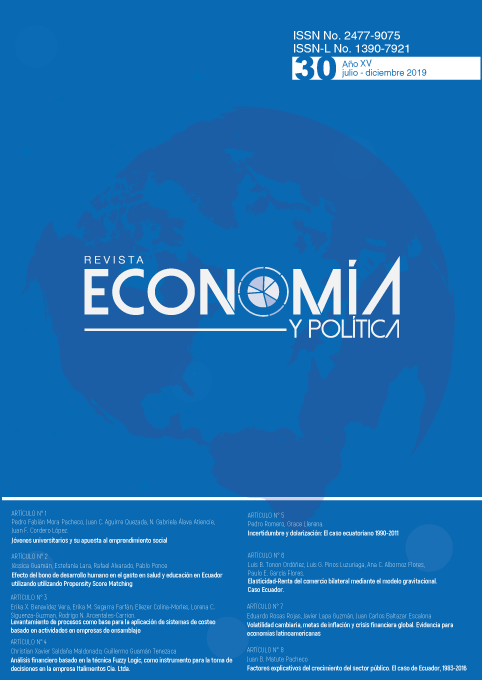Volatilidad cambiaria, metas de inflación y crisis financiera global. Evidencia para economías latinoamericanas
DOI:
https://doi.org/10.25097/rep.n30.2019.07Palabras clave:
Modelos GARCH, volatilidad cambiaria, metas de inflación, crisis financiera globalResumen
El proposito de esta investigación es identificar el efecto asimétrico generado por impactos positivos y negativos en la volatilidad del tipo de cambio. Además de determinar el efecto generado por la implementación del regimen de Metas de Inflación (MI) y la crisis financiera global (CFG) en la varianza condicional de las principales divisas de América Latina (Brasil, Chile, Colombia, México y Perú). Se emplea un modelo asimétrico de heterocedasticidad Condicional Autorregresiva Generalizada, con innovaciones t de student (ARIMA-GJR-GARCH), aplicado sobre datos diarios de 1997 a 2019. Los principales hallazgos muestran que existe un mayor impacto de las depreciaciones cambiarias sobre la volatilidad del tipo de cambio. Además, se encontró que el esquema de MI ha incrementado la volatilidad de las divisas, principalmente en Brasil, Chile y México. Finalmente, la CFG de 2008 parece haber generado un clima de mayor volatilidad en las divisas de la región.
Descargas
Citas
Arestis, P., y Sawyer, M. (2013). Moving from Inflation Targeting to Prices and Incomes Policy. Panoeconomicus, 60(1), 1-17. DOI: https://doi.org/10.2298/PAN1301001A
Ball, L., y Sheridan, N. (2005). Does inflation targeting matter? en Bernanke, B., Woodford, M. (Eds.), The Inflation Targeting Debate. The University of Chicago Press, Chicago, 249–276.
Berganza, J.C., y Broto, C. (2012). Flexible inflation targets, forex interventions and exchange rate volatility in emerging markets. Journal of International Money and Finance, 31, 428–444, Disponible en: https://www.bde.es/f/webpi/SES/staff/berganzajuancarlos/files/flexibleinflationtargets.pdf
Bernanke, B. S. (2004). The Great Moderation, discurso ante la Eastern Economic Association, Washington, 20 de Febrero, Disponible en: www.federalreserve.gov/boarddocs/speeches/2004/20040220/default.htm#f1.
Black, F. (1976). The pricing of commodity contracts, Journal of Financial Economics, 3(1/2), 167-179. DOI: https://doi.org/10.1016/0304-405X(76)90024-6
Böfinger, P. y Wóllmerschaeuser, T. (2001). Managed floating: understanding the New International Monetary Order, Centre for Economic Policy Research (CEPR), Discussion Paper No. 3064. Recuperado de: https://www.econstor.eu/bitstream/10419/48479/1/570611571.pdf
Bollerslev, T. (1986). Generalised Autoregressive Conditional Heteroskedasticity, Journal of Econometrics 31(3), 307-27. DOI: https://doi.org/10.1016/0304-4076(86)90063-1
Brooks C. (2015). Introductory Econometrics for Finance (3rd ed.). Cambridge Inglaterra: Cambridge University Press.
Cavoli, T. (2009). Is fear of floating justifies? The East Asia experience, Journal of Policy Modeling, 31(1), 1-16. DOI: https://doi.org/10.1016/j.jpolmod.2008.03.002
Cohen, M. (2012). The Global Economic Crisis in Latin America: Impacts and Responses, Ed. Taylor and Francis.
Coudert, V., Couharde, C., y Mignon, V. (2011). Exchange Rate Volatility Across Financial Crises. Journal of Banking and Finance 35(11), 3010–3018. DOI: https://doi.org/10.1016/j.jbankfin.2011.04.003
Edwards, S., (2006). The relationship between exchange rates and inflation targeting revisited. In: Mishkin, F., Schmidt-Hebbel, K. (Eds.), Monetary Policy Under Inflation Targeting. Banco Central de Chile, Santiago, pp. 373–413.
Engle, R. F. (1982). Autoregressive Conditional Heteroskedasticity with Estimates of the Variance of United Kingdom Inflation, Econometrica 50(4), 987-1007. Recuperado de: https://www.jstor.org/stable/1912773
Engle, R.F. y Ng, V. N. (1993). Measuring and testing the impact of news on volatility, Journal of Finance, 48(5), 1749-1778. DOI: https://doi.org/10.1111/j.1540-6261.1993.tb05127.x
Frenkel R., y Rapetti M. (2010). A Concise History of Exchange Rate Regimes in Latin America, Working Paper 2010-01, University of Massachusetts, Amherst, MA. Disponible en: https://pdfs.semanticscholar.org/6daf/e27ca9b28bb85365912c4c4a2a16a5846d71.pdf
Gali, J., Monacelli, T. (2005). Monetary policy and exchange rate volatility in a small open economy. Review of Economic Studies 72, 707–734. Disponible en: http://www.crei.cat/wp-content/uploads/users/pages/roes8739.pdf
Glosten, L. R., Jagannathan, R. y Runkle, D. E. (1993). On the Relation Between the Expected Value and the Volatility of the Nominal Excess Return on Stocks, The Journal of Finance 48(5). DOI: https://doi.org/10.1111/j.1540-6261.1993.tb05128.x
Hsu S. (2013). Financial Crises, 1929 to the Present Books, Edward Elgar Publishing, No. 14419.
Fondo Monetario Internacional (2019). Annual Report on Exchange Arrangements and Exchange Restrictions 2018. Washington, DC: IMF. DOI: http://dx.doi.org/10.5089/9781484396773.081
Mandelbrot, B. (1963). The variation of certain speculative prices, The Journal of Business, 36(4), 394-419. DOI: http://dx.doi.org/10.1086/294632
McLeod, A. I. y Li, W. K. (1983). Diagnostic checking ARMA time series models using squared-residual autocorrelations. Journal of Time Series Analysis 4(4): 269–273. DOI: https://doi.org/10.1111/j.1467-9892.1983.tb00373.x
Mishkin F.S., (2001). Prudential supervision: why is it important and what are the issues? en Mishkin F.S. (ed.), Prudential Supervision. What Works and What Doesn’t, National Bureau of Economic Research Working Paper Series, No. 7926.
Mishkin, F.S., y Savastano, M.A. (2001). Monetary policy strategies for Latin America. Journal of Development Economics 66, 415–444. Disponible en: http://isiarticles.com/bundles/Article/pre/pdf/24731.pdf
Nelson, D. B. (1991). Conditional Heteroskedasticity in Asset Returns: A New Approach, Econometrica 59(2), 347-70. Recuperado de: https://www.jstor.org/stable/2938260
Obstfeld, M., Shambaugh, J., y Taylor, A. M. (2005). The Trilemma in History: Tradeoffs among Exchange Rates, Monetary Policies, and Capital Mobility, Review of Economics and Statistics 3, 423–38. Disponible en: https://eml.berkeley.edu/~obstfeld/ost12.pdf
Ouyang, A. Y., Rajan, R. S. y Li, J. (2016). Exchange rate regimes and real exchange rate volatility: Does inflation targeting help or hurt?, Japan and the World Economy, Elsevier, 39, 62-72. DOI: 10.1016/j.japwor.2016.07.002
Perrotini H. I. (2007). El nuevo paradigma monetario. Revista Economía UNAM. (11), 64-82. Disponible en: http://www.redalyc.org/service/redalyc/downloadPdf/3635/363542892001/6
Rose, A. K. (2007). A stable international monetary system Emerges: Inflation targeting is bretton woods, reversed. Journal of International Money and Finance, 26(5), 663-681 DOI: https://doi.org/10.1016/j.jimonfin.2007.04.004
______ (2014). Surprising similarities: recent monetary regimes of small economies. J. Int. Money Finance 49A, 5–27. Disponible en: https://www.frbsf.org/economic-research/files/Rose-AEPC2013.pdf
Stock, J., y Watson, M. (2003). Has the Business Cycle Changed? Evidence and Explanations. Federal Reserve Bank of Kansas City, Kansas City (2003). Disponible en: https://www.princeton.edu/~mwatson/papers/jh_2.pdf
Taylor, S. J. (1986). Forecasting the Volatility of Currency Exchange Rates, International Journal of Forecasting 3(1), 159-70. DOI: https://doi.org/10.1016/0169-2070(87)90085-9
Walsh, C. (2009). Inflation targeting: what have we learned? International Finance 12(2), 195–233. DOI: https://doi.org/10.1111/j.1468-2362.2009.01236.x






